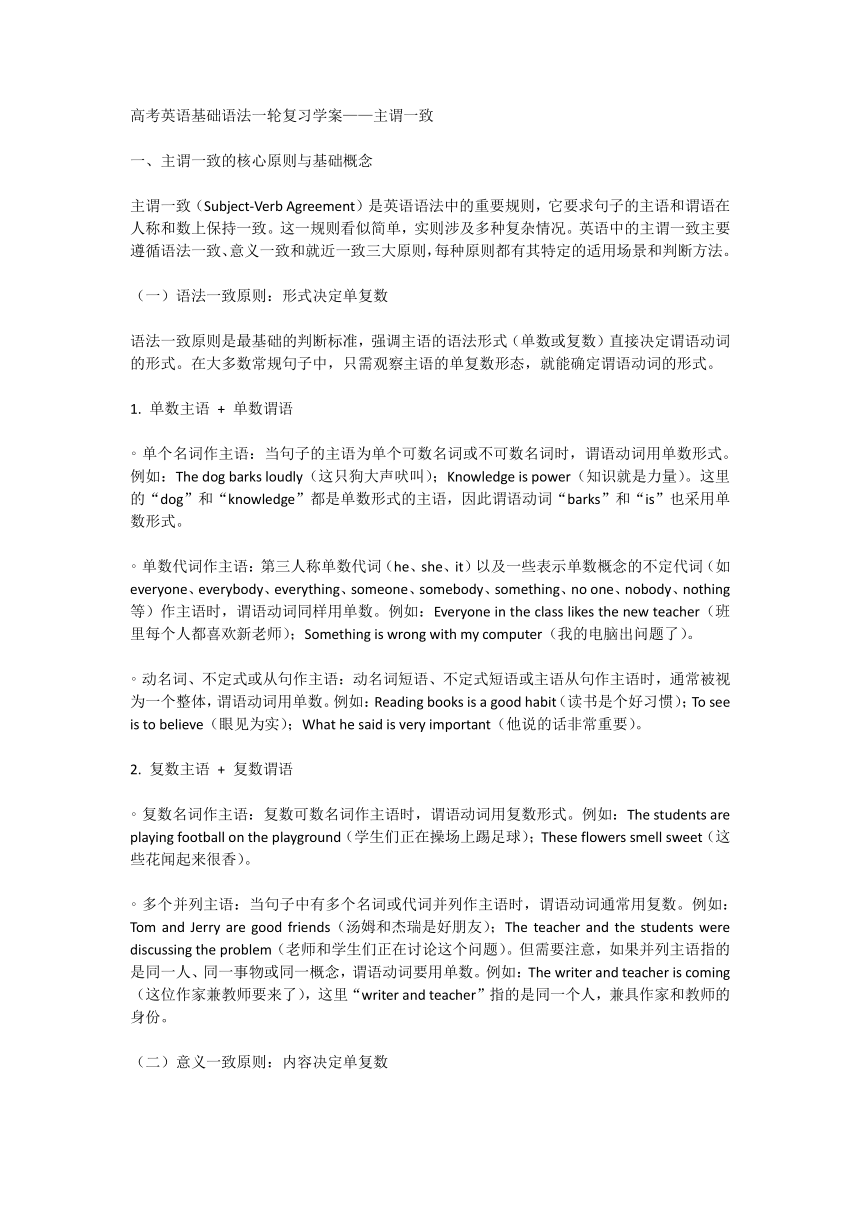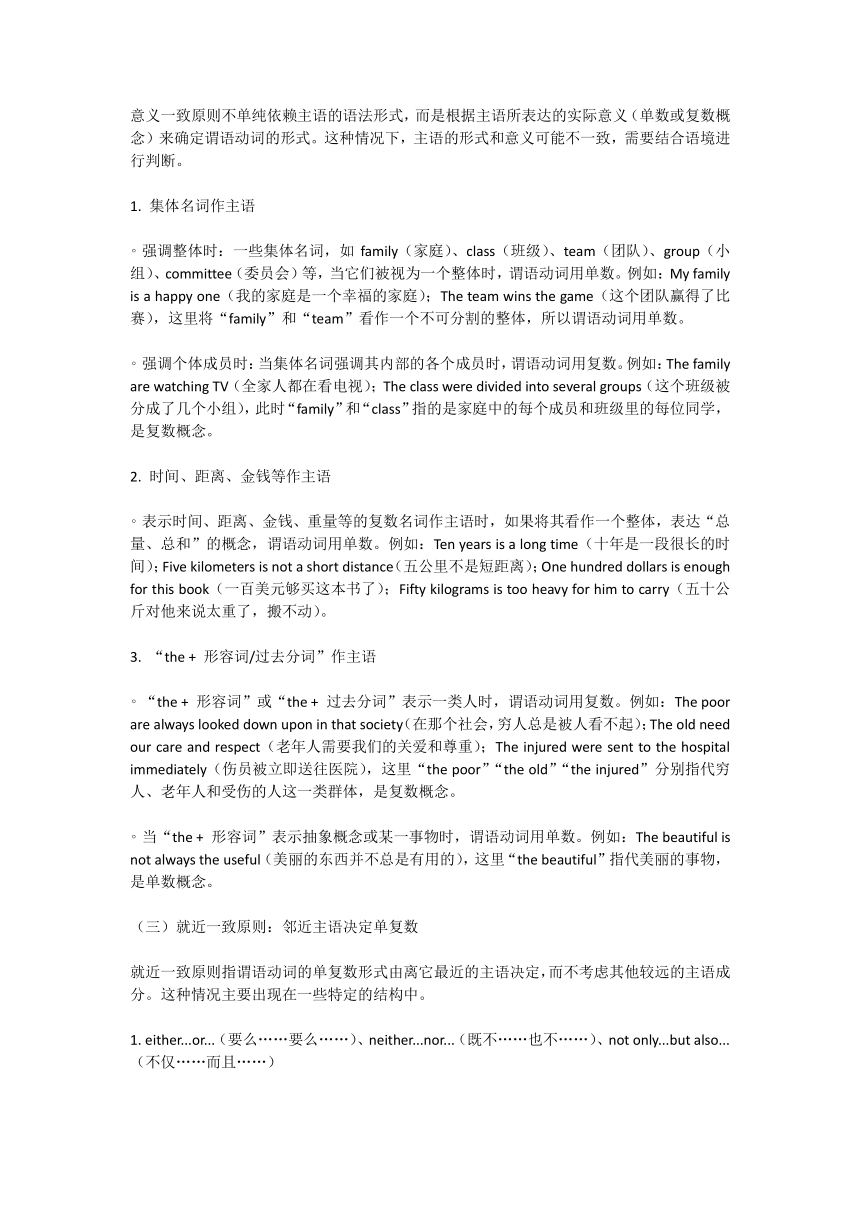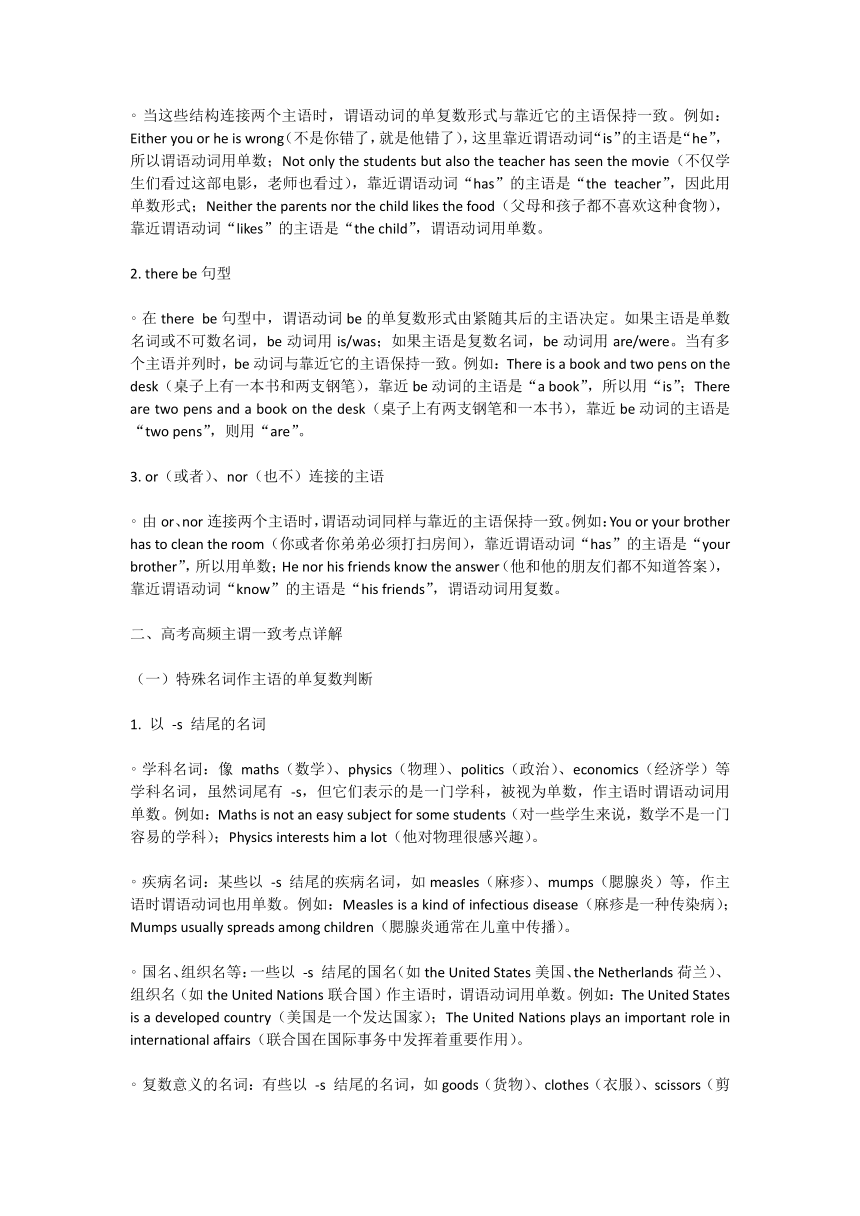高考英语基础语法复习(讲义)—主谓一致
文档属性
| 名称 | 高考英语基础语法复习(讲义)—主谓一致 |  | |
| 格式 | docx | ||
| 文件大小 | 18.1KB | ||
| 资源类型 | 教案 | ||
| 版本资源 | 通用版 | ||
| 科目 | 英语 | ||
| 更新时间 | 2025-06-20 18:57:18 | ||
图片预览



文档简介
高考英语基础语法一轮复习学案——主谓一致
一、主谓一致的核心原则与基础概念
主谓一致(Subject-Verb Agreement)是英语语法中的重要规则,它要求句子的主语和谓语在人称和数上保持一致。这一规则看似简单,实则涉及多种复杂情况。英语中的主谓一致主要遵循语法一致、意义一致和就近一致三大原则,每种原则都有其特定的适用场景和判断方法。
(一)语法一致原则:形式决定单复数
语法一致原则是最基础的判断标准,强调主语的语法形式(单数或复数)直接决定谓语动词的形式。在大多数常规句子中,只需观察主语的单复数形态,就能确定谓语动词的形式。
1. 单数主语 + 单数谓语
单个名词作主语:当句子的主语为单个可数名词或不可数名词时,谓语动词用单数形式。例如:The dog barks loudly(这只狗大声吠叫);Knowledge is power(知识就是力量)。这里的“dog”和“knowledge”都是单数形式的主语,因此谓语动词“barks”和“is”也采用单数形式。
单数代词作主语:第三人称单数代词(he、she、it)以及一些表示单数概念的不定代词(如everyone、everybody、everything、someone、somebody、something、no one、nobody、nothing等)作主语时,谓语动词同样用单数。例如:Everyone in the class likes the new teacher(班里每个人都喜欢新老师);Something is wrong with my computer(我的电脑出问题了)。
动名词、不定式或从句作主语:动名词短语、不定式短语或主语从句作主语时,通常被视为一个整体,谓语动词用单数。例如:Reading books is a good habit(读书是个好习惯);To see is to believe(眼见为实);What he said is very important(他说的话非常重要)。
2. 复数主语 + 复数谓语
复数名词作主语:复数可数名词作主语时,谓语动词用复数形式。例如:The students are playing football on the playground(学生们正在操场上踢足球);These flowers smell sweet(这些花闻起来很香)。
多个并列主语:当句子中有多个名词或代词并列作主语时,谓语动词通常用复数。例如:Tom and Jerry are good friends(汤姆和杰瑞是好朋友);The teacher and the students were discussing the problem(老师和学生们正在讨论这个问题)。但需要注意,如果并列主语指的是同一人、同一事物或同一概念,谓语动词要用单数。例如:The writer and teacher is coming(这位作家兼教师要来了),这里“writer and teacher”指的是同一个人,兼具作家和教师的身份。
(二)意义一致原则:内容决定单复数
意义一致原则不单纯依赖主语的语法形式,而是根据主语所表达的实际意义(单数或复数概念)来确定谓语动词的形式。这种情况下,主语的形式和意义可能不一致,需要结合语境进行判断。
1. 集体名词作主语
强调整体时:一些集体名词,如family(家庭)、class(班级)、team(团队)、group(小组)、committee(委员会)等,当它们被视为一个整体时,谓语动词用单数。例如:My family is a happy one(我的家庭是一个幸福的家庭);The team wins the game(这个团队赢得了比赛),这里将“family”和“team”看作一个不可分割的整体,所以谓语动词用单数。
强调个体成员时:当集体名词强调其内部的各个成员时,谓语动词用复数。例如:The family are watching TV(全家人都在看电视);The class were divided into several groups(这个班级被分成了几个小组),此时“family”和“class”指的是家庭中的每个成员和班级里的每位同学,是复数概念。
2. 时间、距离、金钱等作主语
表示时间、距离、金钱、重量等的复数名词作主语时,如果将其看作一个整体,表达“总量、总和”的概念,谓语动词用单数。例如:Ten years is a long time(十年是一段很长的时间);Five kilometers is not a short distance(五公里不是短距离);One hundred dollars is enough for this book(一百美元够买这本书了);Fifty kilograms is too heavy for him to carry(五十公斤对他来说太重了,搬不动)。
3. “the + 形容词/过去分词”作主语
“the + 形容词”或“the + 过去分词”表示一类人时,谓语动词用复数。例如:The poor are always looked down upon in that society(在那个社会,穷人总是被人看不起);The old need our care and respect(老年人需要我们的关爱和尊重);The injured were sent to the hospital immediately(伤员被立即送往医院),这里“the poor”“the old”“the injured”分别指代穷人、老年人和受伤的人这一类群体,是复数概念。
当“the + 形容词”表示抽象概念或某一事物时,谓语动词用单数。例如:The beautiful is not always the useful(美丽的东西并不总是有用的),这里“the beautiful”指代美丽的事物,是单数概念。
(三)就近一致原则:邻近主语决定单复数
就近一致原则指谓语动词的单复数形式由离它最近的主语决定,而不考虑其他较远的主语成分。这种情况主要出现在一些特定的结构中。
1. either...or...(要么……要么……)、neither...nor...(既不……也不……)、not only...but also...(不仅……而且……)
当这些结构连接两个主语时,谓语动词的单复数形式与靠近它的主语保持一致。例如:Either you or he is wrong(不是你错了,就是他错了),这里靠近谓语动词“is”的主语是“he”,所以谓语动词用单数;Not only the students but also the teacher has seen the movie(不仅学生们看过这部电影,老师也看过),靠近谓语动词“has”的主语是“the teacher”,因此用单数形式;Neither the parents nor the child likes the food(父母和孩子都不喜欢这种食物),靠近谓语动词“likes”的主语是“the child”,谓语动词用单数。
2. there be句型
在there be句型中,谓语动词be的单复数形式由紧随其后的主语决定。如果主语是单数名词或不可数名词,be动词用is/was;如果主语是复数名词,be动词用are/were。当有多个主语并列时,be动词与靠近它的主语保持一致。例如:There is a book and two pens on the desk(桌子上有一本书和两支钢笔),靠近be动词的主语是“a book”,所以用“is”;There are two pens and a book on the desk(桌子上有两支钢笔和一本书),靠近be动词的主语是“two pens”,则用“are”。
3. or(或者)、nor(也不)连接的主语
由or、nor连接两个主语时,谓语动词同样与靠近的主语保持一致。例如:You or your brother has to clean the room(你或者你弟弟必须打扫房间),靠近谓语动词“has”的主语是“your brother”,所以用单数;He nor his friends know the answer(他和他的朋友们都不知道答案),靠近谓语动词“know”的主语是“his friends”,谓语动词用复数。
二、高考高频主谓一致考点详解
(一)特殊名词作主语的单复数判断
1. 以 -s 结尾的名词
学科名词:像maths(数学)、physics(物理)、politics(政治)、economics(经济学)等学科名词,虽然词尾有 -s,但它们表示的是一门学科,被视为单数,作主语时谓语动词用单数。例如:Maths is not an easy subject for some students(对一些学生来说,数学不是一门容易的学科);Physics interests him a lot(他对物理很感兴趣)。
疾病名词:某些以 -s 结尾的疾病名词,如measles(麻疹)、mumps(腮腺炎)等,作主语时谓语动词也用单数。例如:Measles is a kind of infectious disease(麻疹是一种传染病);Mumps usually spreads among children(腮腺炎通常在儿童中传播)。
国名、组织名等:一些以 -s 结尾的国名(如the United States美国、the Netherlands荷兰)、组织名(如the United Nations联合国)作主语时,谓语动词用单数。例如:The United States is a developed country(美国是一个发达国家);The United Nations plays an important role in international affairs(联合国在国际事务中发挥着重要作用)。
复数意义的名词:有些以 -s 结尾的名词,如goods(货物)、clothes(衣服)、scissors(剪刀)、trousers(裤子)、glasses(眼镜)等,本身就是复数形式,作主语时谓语动词用复数。例如:The goods are of high quality(这些货物质量很好);My trousers are too long for me(我的裤子对我来说太长了)。
2. 单复数同形的名词
英语中有一些名词的单数和复数形式相同,常见的有sheep(羊)、deer(鹿)、fish(鱼,强调条数时单复数同形,强调种类时复数为fishes)、Chinese(中国人)、Japanese(日本人)、Swiss(瑞士人)等。这些名词作主语时,需要根据语境来判断其单复数,进而确定谓语动词的形式。例如:A sheep is eating grass on the hill(一只羊正在山上吃草);Some sheep are running around(一些羊在四处奔跑);The Chinese are hard - working people(中国人是勤劳的民族);There are many fish in the lake(湖里有很多鱼,此处指条数);We saw several kinds of fishes in the aquarium(我们在水族馆看到了好几种鱼,此处指种类)。
(二)复合主语与修饰成分的干扰
1. with、together with、as well as、along with、accompanied by等连接的主语
当主语后面跟有with、together with、as well as、along with、accompanied by等短语时,谓语动词的单复数形式要与这些短语前面的主语保持一致,后面的短语只是对主语的补充说明,不影响谓语动词的数。例如:The teacher, together with the students, is going to visit the museum(老师和学生们打算去参观博物馆),这里的主语是“The teacher”,“together with the students”是补充说明,所以谓语动词用单数“is”;My father, as well as my mother, loves me very much(我的父亲和母亲都非常爱我),主语是“My father”,谓语动词用单数“loves”。
2. except、but、besides、including等连接的主语
当主语后接except、but、besides、including等介词短语时,谓语动词的单复数同样由前面的主语决定。例如:Everyone except Tom was late for the meeting(除了汤姆,每个人开会都迟到了),主语是“Everyone”,“except Tom”是补充成分,谓语动词用单数“was”;All the students besides John have finished the homework(除了约翰,所有学生都完成了作业),主语是“All the students”,谓语动词用复数“have”。
3. 分数/百分数 + of + 名词
当“分数/百分数 + of + 名词”结构作主语时,谓语动词的单复数形式由of后面的名词的单复数决定。如果of后面的名词是可数名词复数,谓语动词用复数;如果of后面的名词是不可数名词或可数名词单数,谓语动词用单数。例如:70% of the students in our class are boys(我们班70%的学生是男生),“students”是复数,所以谓语动词用复数“are”;40% of the land is covered with trees(40%的土地被树木覆盖),“land”是不可数名词,谓语动词用单数“is”;One - third of the apple has been eaten by the little boy(这个小男孩已经吃了三分之一的苹果),“apple”是可数名词单数,谓语动词用单数“has”。
4. a number of与the number of
a number of:表示“许多”,后接可数名词复数,作主语时谓语动词用复数。例如:A number of students are playing basketball on the playground(许多学生正在操场上打篮球)。
the number of:表示“……的数量”,后接可数名词复数,但中心词是“number”,作主语时谓语动词用单数。例如:The number of students in our school is increasing(我们学校的学生数量在增加)。
(三)不定代词作主语的规则
1. 表示“每一”的代词:each、either、neither、everyone、everybody、everything、no one、nobody、nothing等作主语时,谓语动词用单数。这些代词强调个体概念,被视为单数主语。例如:Each of the students has a dictionary(每个学生都有一本字典);Either of the answers is correct(两个答案中的任何一个都是正确的);Nobody knows the secret(没有人知道这个秘密)。
2. 表示“一些”或“许多”的代词:some、any、all、most等作主语时,谓语动词的单复数要根据它们所指代的内容来确定。
当指代可数名词复数时,谓语动词用复数。例如:Some of the books are mine(这些书中有一些是我的);All of the students have passed the exam(所有学生都通过了考试)。
当指代不可数名词或可数名词单数时,谓语动词用单数。例如:Some of the water is dirty(有些水是脏的);Most of the work has been finished(大部分工作已经完成了)。
3. other、another、the other
other:单独使用作主语时,通常指代复数概念,谓语动词用复数。例如:Some students like football, and others like basketball(一些学生喜欢足球,其他学生喜欢篮球),这里“others”相当于“other students”,是复数。
another:表示“另一个”,指代单数,作主语时谓语动词用单数。例如:Another of my friends is coming(我的另一个朋友要来了)。
the other:表示两者中的“另一个”,作主语时谓语动词用单数。例如:I have two pens. One is red, and the other is blue(我有两支钢笔。一支是红色的,另一支是蓝色的)。
三、高考真题中的主谓一致考点剖析
1. (2023全国甲卷)
题目:Each of the volunteers ______ willing to help the elderly.
答案:is
解析:“Each of + 复数名词”结构作主语时,“Each”强调个体,被视为单数主语,根据语法一致原则,谓语动词用单数形式“is”。
2. (2022新高考Ⅰ卷)
题目:Not only the players but also the coach ______ looking forward to the match.
答案:is
解析:“not only...but also...”连接两个主语时,遵循就近一致原则,谓语动词的单复数由靠近它的主语“the coach”决定,“the coach”是单数,所以谓语动词用“is”。
3. (2021全国乙卷)
题目:70% of the land ______ covered with forests.
答案:is
解析:“分数 + of + 名词”作主语时,谓语动词的单复数由of后面的名词决定。“land”是不可数名词,所以谓语动词用单数“is”。
4. (2020全国Ⅱ卷)
题目:There ______ a pen, two pencils and an eraser in the box.
答案:is
解析:在there be句型中,遵循就近一致原则,be动词的单复数由靠近它的主语“a pen”决定,“a pen”是单数,所以用“is”。
5. (2019全国Ⅰ卷)
题目:The number of patients ______ increasing rapidly these days.
答案:is
解析:“the number of + 复数名词”表示“……的数量”,中心词是“number”,作主语时谓语动词用单数,所以这里用“is”。
四、主谓一致易错点总结与复习建议
(一)易错点梳理
1. 集体名词的单复数混淆:不能准确区分集体名词在强调整体和强调个体成员时的不同用法,导致谓语动词单复数错误。例如,误将“The family are a happy one”(正确应为“The family is a happy one”,这里family强调整体)中的谓语动词用复数。
2. 修饰成分的干扰:受with、as well as等短语的影响,
一、主谓一致的核心原则与基础概念
主谓一致(Subject-Verb Agreement)是英语语法中的重要规则,它要求句子的主语和谓语在人称和数上保持一致。这一规则看似简单,实则涉及多种复杂情况。英语中的主谓一致主要遵循语法一致、意义一致和就近一致三大原则,每种原则都有其特定的适用场景和判断方法。
(一)语法一致原则:形式决定单复数
语法一致原则是最基础的判断标准,强调主语的语法形式(单数或复数)直接决定谓语动词的形式。在大多数常规句子中,只需观察主语的单复数形态,就能确定谓语动词的形式。
1. 单数主语 + 单数谓语
单个名词作主语:当句子的主语为单个可数名词或不可数名词时,谓语动词用单数形式。例如:The dog barks loudly(这只狗大声吠叫);Knowledge is power(知识就是力量)。这里的“dog”和“knowledge”都是单数形式的主语,因此谓语动词“barks”和“is”也采用单数形式。
单数代词作主语:第三人称单数代词(he、she、it)以及一些表示单数概念的不定代词(如everyone、everybody、everything、someone、somebody、something、no one、nobody、nothing等)作主语时,谓语动词同样用单数。例如:Everyone in the class likes the new teacher(班里每个人都喜欢新老师);Something is wrong with my computer(我的电脑出问题了)。
动名词、不定式或从句作主语:动名词短语、不定式短语或主语从句作主语时,通常被视为一个整体,谓语动词用单数。例如:Reading books is a good habit(读书是个好习惯);To see is to believe(眼见为实);What he said is very important(他说的话非常重要)。
2. 复数主语 + 复数谓语
复数名词作主语:复数可数名词作主语时,谓语动词用复数形式。例如:The students are playing football on the playground(学生们正在操场上踢足球);These flowers smell sweet(这些花闻起来很香)。
多个并列主语:当句子中有多个名词或代词并列作主语时,谓语动词通常用复数。例如:Tom and Jerry are good friends(汤姆和杰瑞是好朋友);The teacher and the students were discussing the problem(老师和学生们正在讨论这个问题)。但需要注意,如果并列主语指的是同一人、同一事物或同一概念,谓语动词要用单数。例如:The writer and teacher is coming(这位作家兼教师要来了),这里“writer and teacher”指的是同一个人,兼具作家和教师的身份。
(二)意义一致原则:内容决定单复数
意义一致原则不单纯依赖主语的语法形式,而是根据主语所表达的实际意义(单数或复数概念)来确定谓语动词的形式。这种情况下,主语的形式和意义可能不一致,需要结合语境进行判断。
1. 集体名词作主语
强调整体时:一些集体名词,如family(家庭)、class(班级)、team(团队)、group(小组)、committee(委员会)等,当它们被视为一个整体时,谓语动词用单数。例如:My family is a happy one(我的家庭是一个幸福的家庭);The team wins the game(这个团队赢得了比赛),这里将“family”和“team”看作一个不可分割的整体,所以谓语动词用单数。
强调个体成员时:当集体名词强调其内部的各个成员时,谓语动词用复数。例如:The family are watching TV(全家人都在看电视);The class were divided into several groups(这个班级被分成了几个小组),此时“family”和“class”指的是家庭中的每个成员和班级里的每位同学,是复数概念。
2. 时间、距离、金钱等作主语
表示时间、距离、金钱、重量等的复数名词作主语时,如果将其看作一个整体,表达“总量、总和”的概念,谓语动词用单数。例如:Ten years is a long time(十年是一段很长的时间);Five kilometers is not a short distance(五公里不是短距离);One hundred dollars is enough for this book(一百美元够买这本书了);Fifty kilograms is too heavy for him to carry(五十公斤对他来说太重了,搬不动)。
3. “the + 形容词/过去分词”作主语
“the + 形容词”或“the + 过去分词”表示一类人时,谓语动词用复数。例如:The poor are always looked down upon in that society(在那个社会,穷人总是被人看不起);The old need our care and respect(老年人需要我们的关爱和尊重);The injured were sent to the hospital immediately(伤员被立即送往医院),这里“the poor”“the old”“the injured”分别指代穷人、老年人和受伤的人这一类群体,是复数概念。
当“the + 形容词”表示抽象概念或某一事物时,谓语动词用单数。例如:The beautiful is not always the useful(美丽的东西并不总是有用的),这里“the beautiful”指代美丽的事物,是单数概念。
(三)就近一致原则:邻近主语决定单复数
就近一致原则指谓语动词的单复数形式由离它最近的主语决定,而不考虑其他较远的主语成分。这种情况主要出现在一些特定的结构中。
1. either...or...(要么……要么……)、neither...nor...(既不……也不……)、not only...but also...(不仅……而且……)
当这些结构连接两个主语时,谓语动词的单复数形式与靠近它的主语保持一致。例如:Either you or he is wrong(不是你错了,就是他错了),这里靠近谓语动词“is”的主语是“he”,所以谓语动词用单数;Not only the students but also the teacher has seen the movie(不仅学生们看过这部电影,老师也看过),靠近谓语动词“has”的主语是“the teacher”,因此用单数形式;Neither the parents nor the child likes the food(父母和孩子都不喜欢这种食物),靠近谓语动词“likes”的主语是“the child”,谓语动词用单数。
2. there be句型
在there be句型中,谓语动词be的单复数形式由紧随其后的主语决定。如果主语是单数名词或不可数名词,be动词用is/was;如果主语是复数名词,be动词用are/were。当有多个主语并列时,be动词与靠近它的主语保持一致。例如:There is a book and two pens on the desk(桌子上有一本书和两支钢笔),靠近be动词的主语是“a book”,所以用“is”;There are two pens and a book on the desk(桌子上有两支钢笔和一本书),靠近be动词的主语是“two pens”,则用“are”。
3. or(或者)、nor(也不)连接的主语
由or、nor连接两个主语时,谓语动词同样与靠近的主语保持一致。例如:You or your brother has to clean the room(你或者你弟弟必须打扫房间),靠近谓语动词“has”的主语是“your brother”,所以用单数;He nor his friends know the answer(他和他的朋友们都不知道答案),靠近谓语动词“know”的主语是“his friends”,谓语动词用复数。
二、高考高频主谓一致考点详解
(一)特殊名词作主语的单复数判断
1. 以 -s 结尾的名词
学科名词:像maths(数学)、physics(物理)、politics(政治)、economics(经济学)等学科名词,虽然词尾有 -s,但它们表示的是一门学科,被视为单数,作主语时谓语动词用单数。例如:Maths is not an easy subject for some students(对一些学生来说,数学不是一门容易的学科);Physics interests him a lot(他对物理很感兴趣)。
疾病名词:某些以 -s 结尾的疾病名词,如measles(麻疹)、mumps(腮腺炎)等,作主语时谓语动词也用单数。例如:Measles is a kind of infectious disease(麻疹是一种传染病);Mumps usually spreads among children(腮腺炎通常在儿童中传播)。
国名、组织名等:一些以 -s 结尾的国名(如the United States美国、the Netherlands荷兰)、组织名(如the United Nations联合国)作主语时,谓语动词用单数。例如:The United States is a developed country(美国是一个发达国家);The United Nations plays an important role in international affairs(联合国在国际事务中发挥着重要作用)。
复数意义的名词:有些以 -s 结尾的名词,如goods(货物)、clothes(衣服)、scissors(剪刀)、trousers(裤子)、glasses(眼镜)等,本身就是复数形式,作主语时谓语动词用复数。例如:The goods are of high quality(这些货物质量很好);My trousers are too long for me(我的裤子对我来说太长了)。
2. 单复数同形的名词
英语中有一些名词的单数和复数形式相同,常见的有sheep(羊)、deer(鹿)、fish(鱼,强调条数时单复数同形,强调种类时复数为fishes)、Chinese(中国人)、Japanese(日本人)、Swiss(瑞士人)等。这些名词作主语时,需要根据语境来判断其单复数,进而确定谓语动词的形式。例如:A sheep is eating grass on the hill(一只羊正在山上吃草);Some sheep are running around(一些羊在四处奔跑);The Chinese are hard - working people(中国人是勤劳的民族);There are many fish in the lake(湖里有很多鱼,此处指条数);We saw several kinds of fishes in the aquarium(我们在水族馆看到了好几种鱼,此处指种类)。
(二)复合主语与修饰成分的干扰
1. with、together with、as well as、along with、accompanied by等连接的主语
当主语后面跟有with、together with、as well as、along with、accompanied by等短语时,谓语动词的单复数形式要与这些短语前面的主语保持一致,后面的短语只是对主语的补充说明,不影响谓语动词的数。例如:The teacher, together with the students, is going to visit the museum(老师和学生们打算去参观博物馆),这里的主语是“The teacher”,“together with the students”是补充说明,所以谓语动词用单数“is”;My father, as well as my mother, loves me very much(我的父亲和母亲都非常爱我),主语是“My father”,谓语动词用单数“loves”。
2. except、but、besides、including等连接的主语
当主语后接except、but、besides、including等介词短语时,谓语动词的单复数同样由前面的主语决定。例如:Everyone except Tom was late for the meeting(除了汤姆,每个人开会都迟到了),主语是“Everyone”,“except Tom”是补充成分,谓语动词用单数“was”;All the students besides John have finished the homework(除了约翰,所有学生都完成了作业),主语是“All the students”,谓语动词用复数“have”。
3. 分数/百分数 + of + 名词
当“分数/百分数 + of + 名词”结构作主语时,谓语动词的单复数形式由of后面的名词的单复数决定。如果of后面的名词是可数名词复数,谓语动词用复数;如果of后面的名词是不可数名词或可数名词单数,谓语动词用单数。例如:70% of the students in our class are boys(我们班70%的学生是男生),“students”是复数,所以谓语动词用复数“are”;40% of the land is covered with trees(40%的土地被树木覆盖),“land”是不可数名词,谓语动词用单数“is”;One - third of the apple has been eaten by the little boy(这个小男孩已经吃了三分之一的苹果),“apple”是可数名词单数,谓语动词用单数“has”。
4. a number of与the number of
a number of:表示“许多”,后接可数名词复数,作主语时谓语动词用复数。例如:A number of students are playing basketball on the playground(许多学生正在操场上打篮球)。
the number of:表示“……的数量”,后接可数名词复数,但中心词是“number”,作主语时谓语动词用单数。例如:The number of students in our school is increasing(我们学校的学生数量在增加)。
(三)不定代词作主语的规则
1. 表示“每一”的代词:each、either、neither、everyone、everybody、everything、no one、nobody、nothing等作主语时,谓语动词用单数。这些代词强调个体概念,被视为单数主语。例如:Each of the students has a dictionary(每个学生都有一本字典);Either of the answers is correct(两个答案中的任何一个都是正确的);Nobody knows the secret(没有人知道这个秘密)。
2. 表示“一些”或“许多”的代词:some、any、all、most等作主语时,谓语动词的单复数要根据它们所指代的内容来确定。
当指代可数名词复数时,谓语动词用复数。例如:Some of the books are mine(这些书中有一些是我的);All of the students have passed the exam(所有学生都通过了考试)。
当指代不可数名词或可数名词单数时,谓语动词用单数。例如:Some of the water is dirty(有些水是脏的);Most of the work has been finished(大部分工作已经完成了)。
3. other、another、the other
other:单独使用作主语时,通常指代复数概念,谓语动词用复数。例如:Some students like football, and others like basketball(一些学生喜欢足球,其他学生喜欢篮球),这里“others”相当于“other students”,是复数。
another:表示“另一个”,指代单数,作主语时谓语动词用单数。例如:Another of my friends is coming(我的另一个朋友要来了)。
the other:表示两者中的“另一个”,作主语时谓语动词用单数。例如:I have two pens. One is red, and the other is blue(我有两支钢笔。一支是红色的,另一支是蓝色的)。
三、高考真题中的主谓一致考点剖析
1. (2023全国甲卷)
题目:Each of the volunteers ______ willing to help the elderly.
答案:is
解析:“Each of + 复数名词”结构作主语时,“Each”强调个体,被视为单数主语,根据语法一致原则,谓语动词用单数形式“is”。
2. (2022新高考Ⅰ卷)
题目:Not only the players but also the coach ______ looking forward to the match.
答案:is
解析:“not only...but also...”连接两个主语时,遵循就近一致原则,谓语动词的单复数由靠近它的主语“the coach”决定,“the coach”是单数,所以谓语动词用“is”。
3. (2021全国乙卷)
题目:70% of the land ______ covered with forests.
答案:is
解析:“分数 + of + 名词”作主语时,谓语动词的单复数由of后面的名词决定。“land”是不可数名词,所以谓语动词用单数“is”。
4. (2020全国Ⅱ卷)
题目:There ______ a pen, two pencils and an eraser in the box.
答案:is
解析:在there be句型中,遵循就近一致原则,be动词的单复数由靠近它的主语“a pen”决定,“a pen”是单数,所以用“is”。
5. (2019全国Ⅰ卷)
题目:The number of patients ______ increasing rapidly these days.
答案:is
解析:“the number of + 复数名词”表示“……的数量”,中心词是“number”,作主语时谓语动词用单数,所以这里用“is”。
四、主谓一致易错点总结与复习建议
(一)易错点梳理
1. 集体名词的单复数混淆:不能准确区分集体名词在强调整体和强调个体成员时的不同用法,导致谓语动词单复数错误。例如,误将“The family are a happy one”(正确应为“The family is a happy one”,这里family强调整体)中的谓语动词用复数。
2. 修饰成分的干扰:受with、as well as等短语的影响,
